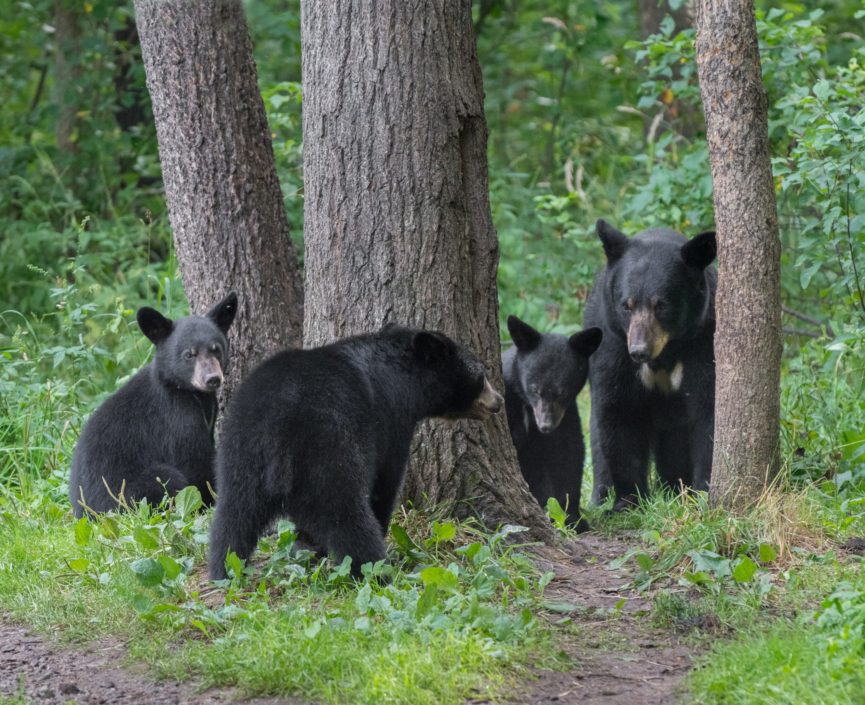By: Richard P. Smith.
During 2018, the DNR estimated there were 13,756 black bears in the state that were at least a year old on September 1, 2017. The estimate for the UP was 10,799 and 2,957 of those were in the northern LP.
In 2019, the DNR estimated the state’s bear population was only 12,408 animals at least a year old on September 1, 2018, with 9,761 of those living in the UP and 2,647 residing in the northern LP. In other words, the population declined by 1,348 in one year’s time when the population had been increasing every year since 2012 due to a major reduction in the number of bear licenses issued by the state. And the number of bears registered by hunters during 2018 (1,489) was the lowest it has been during recent years.
Prior to 2019, enough yearling bears entered the population each year to offset even higher harvests than occurred in 2018 and still resulted in an increase of the number of bears legal to hunters. There were 1,912 bears registered by hunters in 2017, for instance. In order for the number of bears in the state to have declined so much between 2018 and 2019, something catastrophic had to have happened. Either that, or the current method the DNR is using to estimate bear numbers is subject to major fluctuations that have more to do with hunter success related to availability of natural foods and weather rather than real changes in bear numbers.
Most likely it’s the statistical reconstruction model the DNR is currently using to estimate bear numbers rather than a decline in the bear population. The DNR has been using the computer model to estimate the state’s bear population since 2014. The model is entirely dependent upon the sex and age of bears bagged by hunters each year as well as hunting effort. The DNR has that data going back to 1992. When new data from current seasons are available, that’s plugged into the model to generate a new estimate.
DNR research specialist Sarah Mayhew is responsible for processing the DNR’s bear population reconstruction computer model.
She said, “All of the information is plugged into the program and it goes through a number of scenarios to determine what the bear population was most likely to have been like to produce the harvest that we know we had, given the other data that is known.”
A population model that relies so heavily on harvest data is bound to vary depending upon the most recent harvest. A low harvest like what occurred during 2018 is bound to generate a reduced population estimate such as the one for September 1, 2018. A high harvest like the one during 2017 has more of a tendency to reflect an increasing bear population like the one arrived at for September 1, 2017.
Bear population estimates can vary so widely with the DNR’s computer model from one year to the next that new figures can totally eliminate previous estimates. That’s what happened with the estimate generated in 2019. After data from 2018 bear seasons was entered, the model calculated that the number of legal bears in the UP during 2017 was only 10,000 and not 10,799, and then declined to 9,761 by the fall of 2018. The model estimated there were only about 2,750 legal bears in the northern LP in 2017, which declined to 2,647 by 2018.
Cody Norton is the DNR’s new bear specialist, who works out of the Marquette office.
“Every time we enter a new year’s worth of data in the model it recalculates what it thinks the bear population was like for previous years besides the new year. That’s the way it works. That’s why there was such a change between estimates for 2017 and 2018,” said Norton
In reality, the abundance of natural foods during 2018 was most likely the reason why fewer bears were bagged by hunters and not a reduction in bear numbers. The model does not take into account factors that affect hunting success like that.
“We tried incorporating food abundance in the model,” Norton commented, “and it simply didn’t work. Michigan State University tried developing an index for how abundant acorns were on an annual basis. They didn’t get input from enough sources to make that index reliable.”
The DNR readily admits that computer models are not exact. They are only as good as information that goes into them and the one being used to estimate bear numbers does not currently incorporate all of the information that plays a role in bear hunting success and harvest. Hunters should keep that in mind when viewing estimates generated by the model.
Richard P. Smith can be reached at: rpsoutdoors@chartermi.net
- 2023’s Highest Scoring Bears - February 24, 2025
- A Michigan Bear – one of the biggest! - February 15, 2024
- Red Black Bear Killed In U.P. - July 13, 2022

